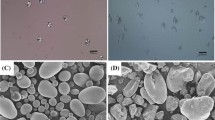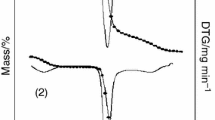Abstract
The use of chemically modified starches is widely accepted in various industries, with several applications. In this research, natural cassava starch granules were treated with standard sodium hypochlorite solution at 0.8, 2.0, and 5.0 g Cl/100 g starch. The native and modified starch samples were investigated by means of the following techniques: simultaneous thermogravimetry–differential thermal analysis, which allowed us to verify the thermal decomposition associated with endothermic or exothermic phenomena; and differential scanning calorimetry that was used to determine gelatinization enthalpy as well as the rapid viscoamylographic analysis that provided the pasting temperature and viscosity. By means of non-contact-atomic force microscopy method and X-ray powder patterns diffractometry, it was possible to observe the surface morphology, topography of starch granules, and alterations in the granules’ crystallinity.





Similar content being viewed by others
References
Moorthy SN. Physicochemical and functional properties of tropical tuber starches: a review. Starch/Stärke. 2002;54:559–92.
Hoover R. Composition, molecular structure and physicochemical properties of tuber and root starches: a review. Carbohydr Polym. 2001;45:253–67.
Schuttleworth PS, Budarin V, Clark JH. Thermal investigation of ‘molten starch’. J Therm Anal Calorim. 2011;105:577–81.
Leivas CL, Costa FJOG, Almeida RR, Freitas RJS, Stertz SC, Schnitzler E. Structural characteristics, physico-chemical, thermal and pasting properties of potato (Solanum tuberosum, L.) flour: study of different cultivars and granulometries. J Therm Anal Calorim. 2012. doi:10.1007/s10973-012-2395-2.
Haynes L, Schuenzel M. Flour starch thermal characteristics. Modulated scanning calorimetric studies. J Therm Anal Calorim. 2011;106:261–6.
Costa FJOG, Almeida RR, Lacerda LG, Filho MASC, Bannach G, Schnitzler E. Thermoanalytical study of native cassava starch and treated with hydrogen peroxide. Alim Nutr. 2011;22:7–15.
Beninca C, Demiate IM, Lacerda LG, Filho MASC, Ionashiro M, Schnitzler E. Thermal behavior of corn starch granules modified by acid treatment at 30 and 50 °C. Ecl Quim. 2008;33:13–8.
Lacerda LG, Filho MASC, Demiate IM, Bannach G, Ionashiro M, Schnitzler E. Thermal behaviour of corn starch granules under action of fungal α-amylase. J Therm Anal Calorim. 2008;93:445–9.
Rudnik E, Matuschek G, Milanov N, Kettrup A. Thermal stability and degradation of starch derivatives. J Therm Anal Calorim. 2006;85:267–70.
Muhrbeck P, Eliasson AC, Salomonsson A-C. Physical characterization of bromine oxidized potato starch. Starch/Stärke. 1990;42:418–20.
Harmon RE, Gupta SK, Johnson J. Oxidation of starch catalyzed by persulfate. Starch/Stärke. 2006;23:197–9.
Takizawa FF, Silva GO, Konkel FE, Demiate IM. Characterization of tropical starches modified with potassium permanganate and lactic acid. Braz Arch Biol Technol. 2004;47:921–31.
Wurzburg OB. Modified starches: properties and uses. Boca Raton: CRC; 1989.
Silva RM, Ferreira GF, Shirai MA, Haas A, Scherer ML, Franco CML, Demiate IM. Características físico-químicas de amidos modificados com permanganato de potássio/ácido lático e hipoclorito de sódio/ácido lático. Ciênc Tecnol Aliment. 2008;28:66–77.
Zhang Y-R, Wang X-L, Zhao G-M, Wang Y-Z. Preparation and properties of oxidized starch with high degree of oxidation. Carbohydr Polym. 2012;87:2554–62.
Kuakpetoon D, Wang Y-J. Characterization of different starches oxidized by hypochlorite. Starch/Stärke. 2001;53:211–8.
BeMiller J, Wistler R. Starch—chemistry and technology. 3rd ed. Amsterdam: Elsevier; 2009.
Bicudo SCW, Demiate IM, Bannach G, Lacerda LG, Filho MASC, Ionashiro M, Schnitzler E. Thermoanalytical study and characterization of native starches of Paraná pine seeds (Araucaria angustiofolia, Bert O. Ktze) and European chestnut seeds (Castanea sativa, Mill). Ecl Quím 2009;34:7–12.
Aggarwal P, Dollimore D. A comparative study of the degradation of different starches using thermal analysis. Talanta. 1996;43:1527–30.
Soliman AAA, El-Shinnavy N, Mobarak F. Thermal behavior of oxidized starch. Thermochim Acta. 1997;296:149–53.
Aggarwal P, Dollimore D. The effect of chemical modification on starch studied using thermal analysis. Thermochim Acta. 1998;324:1–8.
Aggarwal P, Dollimore D. Degradation of starchy food material by thermal analysis. Thermochim Acta. 2000;357–8:57–63.
Aggarwal P, Dollimore D. A thermal analysis investigation of partially hydrolyzed starch. Thermochim Acta. 1998;329:17–25.
Aggarwal P, Dollimore D, Heon K. Comparative thermal analysis of two biopolymers, starch and cellulose. J Therm Anal. 1997;50:7–17.
Kewtatip K, Tanrattanakul V, Mézaros K, Pavličević J, Budinski-Simendić J. Thermal properties and morphology of cassava starch grafted with different content of polystyrene. J Therm Anal Calorim. 2010;102:1035–41.
Juszczak L, Fortuna T, Krok F. Non-contact atomic force microscopy of starch granules surface. Part I. Potato and tapioca starches. Starch/Stärke. 2008;55:1–7.
Juszczak L, Fortuna T, Krok F. Non-contact atomic force microscopy of starch granules surface. Part II. Selected cereal starches. Starch/Stärke. 2008;55:8–18.
Zhang L, Xie W, Zhao X, Liu Y, Gao W. Study on the morphology, crystalline structure and thermal properties of yellow ginger starch acetates with different degrees of substitution. Thermochim Acta. 2009;495:57–62.
Acknowledgements
The financial resources for this study were provided by the Fundação Araucária-PR-Brazil, the FINEP-Brazil, the CAPES-Brazil, and the CNPq-Brazil, which the authors gratefully acknowledge.
Author information
Authors and Affiliations
Corresponding author
Rights and permissions
About this article
Cite this article
Beninca, C., Colman, T.A.D., Lacerda, L.G. et al. Thermal, rheological, and structural behaviors of natural and modified cassava starch granules, with sodium hypochlorite solutions. J Therm Anal Calorim 111, 2217–2222 (2013). https://doi.org/10.1007/s10973-012-2592-z
Received:
Accepted:
Published:
Issue Date:
DOI: https://doi.org/10.1007/s10973-012-2592-z




